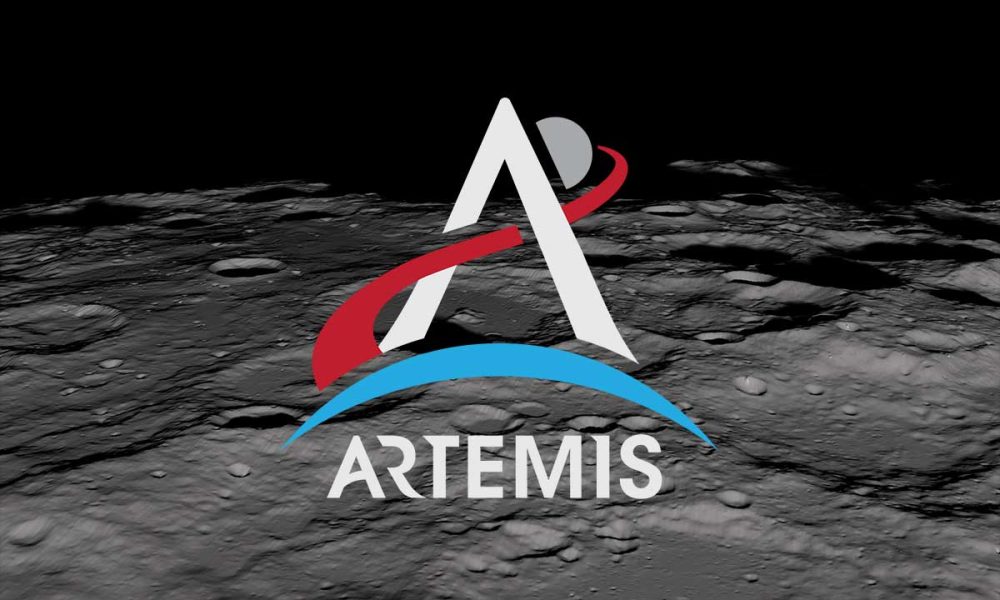The Artemis Program
The last time mankind walked on the Moon was in December 1972, now more than 50 years ago. This fact has been a constant disappointment for space enthusiasts, especially considering the ambitious, bright future of space exploration that seemed to be waiting for us in the 1970s.
Source: Apollo 11 Space
But budget cuts, technological limitations, and the end of the Cold War have put a halt to manned space programs, with currently the farthest people traveling to space staying in Earth’s orbit in the ISS, itself likely to be decommissioned soon.
Luckily, a new wave of space exploration is coming, with the heating up of a new space race. This race is propelled by the progress made by companies like SpaceX, radically decreasing the cost of reaching orbit, as well as the ascendance of China as a world power, actively competing with the US and its allies for the establishment of lunar and maybe even Martian bases.
It is in this context that NASA has designed the Artemis missions, named after the Greek goddess of the Moon, along with contributions by various space agencies.
The program’s long-term goal is to establish a permanent base on the Moon, to later further the possibility of off-world manufacturing and to facilitate human missions to Mars.
The program has however a troubled history, with multiple delays in the past and likely more to come, and might be overhauled in some aspect before it ends, notably regarding its rocket launcher, the SLS.
Still, with a Trump administration including Elon Musk, and an overall a goal to “make America great again”, it is clear that succeeding in this new space race will be as much a matter of national pride as a question of scientific and engineering progress.
Not A Repeat Of Apollo
Lumped together in the Artemis Program is a series of separate missions building onto one another. This is done so that each key technology can be tested one at a time, maximizing the success chances and the safety of the astronauts, while also building the required infrastructures for long-duration stay on the Moon.
This is very different from the spirit of the Apollo missions which were all designed for very short visits, the longest being 75 hours with Apollo 17, mostly aiming at national prestige and collection of rock samples.
The Artemis program is a massive international project, involving the USA, Canada, EU, UK, and many other countries as part of the Artemis Accords.

Source: NASA
The Artemis Accords focus on a peaceful and transparent exploration of the Moon, with principles of interoperability, emergency assistance, avoiding interference between programs, timely open release of scientific data, and the preservation of space heritage.
Why Stay On The Moon?
Besides the scientific interest of a stay on the Moon, allowing for a much deeper understanding of Earth’s only natural satellite, there are many practical reasons for a semi-permanent or permanent human presence on the Moon.
Testing What Works
The first one is that this makes for a very good location to test permanent off-Earth settlements. Thanks to the close proximity to Earth, it is easier to send more cargo at a lower cost than on more distant planetary bodies like Mars.
This short distance also puts any emergency resupply or rescue effort at only a 3-day flight, instead of months and years. So with a lot of yet unproven technologies and concepts to be deployed on the Artemis program, it makes sense to calculate the possibility of quick intervention in case something goes wrong.
A Stepping Stone For Mars
Once a sustained stay is established on the Moon, more ambitious programs like the first human landing on Mars could be considered. As Mars is 6-18 months away, all the lessons learned on the Moon will be extremely valuable to avoid a catastrophic failure on the red planet.
The landing of heavy equipment on the Moon will also provide key insights on how to deal with moving in space a mass of equipment several orders of magnitude larger than what the Apollo missions required.

Source: New Scientist
Lastly, lunar resources could become a crucial supply of fuel and even raw materials for the spaceships on the way to Mars.
In-Situ Resources Exploitation
The Moon is a massive planetary body, with a composition very similar to Earth’s crust. It might also contain some significant water resources in the form of ice hidden in its deepest craters. In 2020, a NASA satellite discovered significant water resources in the permanently shadowed regions of the Moon.
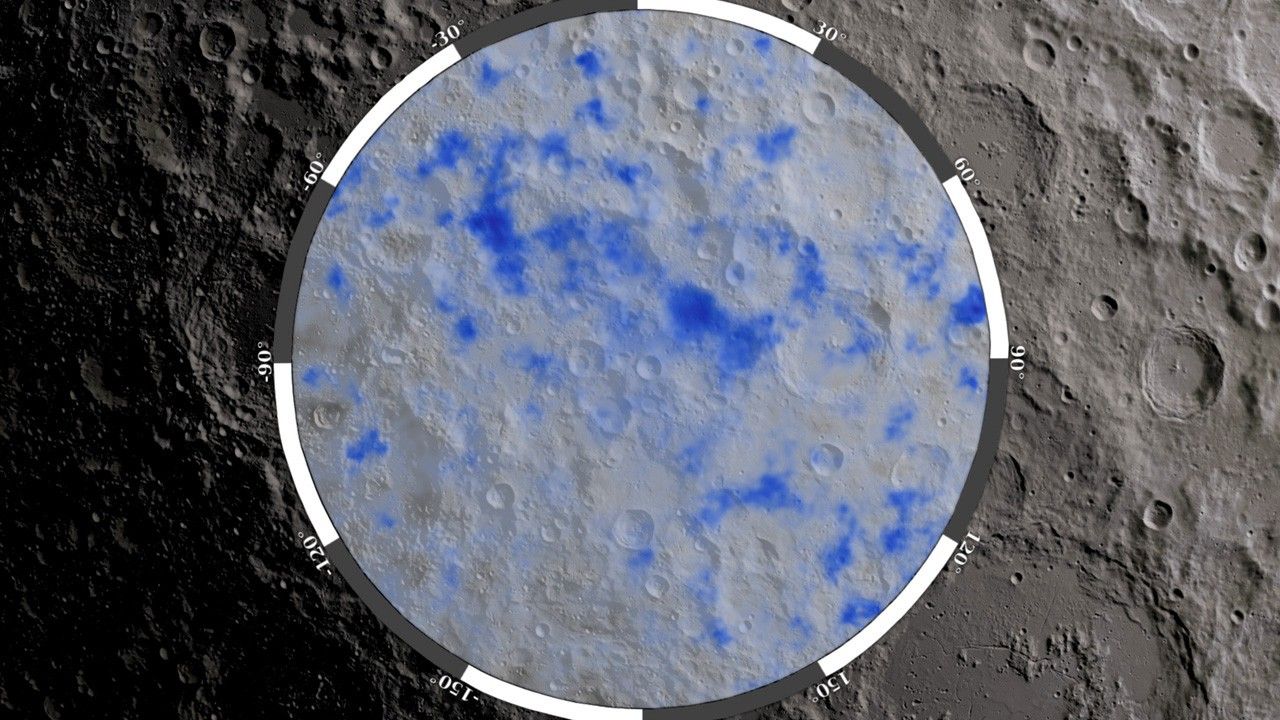
Source: NASA
Because the Moon’s gravity is only 1/6th of Earth, lifting materials from it is a lot less difficult. So production of hydrogen & oxygen fuel, or water for shielding against radiation for a trip to Mars might be easier and cheaper to acquire from the Moon than to lift it from Earth.
However, remote exploitation of these resources is likely to be complex, and direct human-operated mining operations are more likely.
In the long run, the lunar regolith is the most interesting, rich in aluminum, magnesium, iron, silicate, and oxygen.

Source: AnthroFuturism
These mineral resources could form the basis of a Moon-based manufacturing system, where the bulk of satellites and interplanetary spaceships, including solar panels, are built on the Moon, with the high-tech components from Earth only added later on.
Such manufacturing capacity could also be the basis for a massive system for energy generation from orbital solar panels, as we discussed in “Space-Based Energy Solutions For Endless Clean Energy”.
Lastly, the Moon is rich in helium-3, a rare element that could make commercial nuclear fusion easier to achieve, which could be important if the tritium-deuterium fusion method favored by ITER proves impractical (follow the link for a full article on this megaproject).
NASA has already been preparing for in-situ resource exploitation, notably with a long series of robotic probes: the Lunar Reconnaissance Orbiter and several lunar CubeSat for underground water detection, the Volatiles Investigating Polar Exploration Rover (VIPER) for water volume evaluation, Lunar CRater Observation and Sensing Satellite (LCROSS) for lunar regolith composition, and even the Mars Oxygen In-Situ Resource Utilization Experiment (MOXIE) for oxygen production on Mars.
The Many Artemis Missions
Artemis 1
Artemis 1 happened at the end of 2022 and was an uncrewed lunar flight test that lasted 25 days.
This was the first launch with the SLS launcher. SLS is a non-reusable launcher, with a dimension and payload similar to the Apollo’s Saturn V. You see an overview of the Artemis missions’ design in this video by NASA:
Artemis was done to test the SLS, but also the 78,000 pounds (35 tons) Orion spacecraft, which will be carrying the astronauts to the Moon in the rest of the Artemis program. For this mission, mannequins equipped with sensors will take the place of crew members, recording acceleration, vibration, and radiation levels.
The Artemis 1’s measurements showed that while radiation exposure can vary depending on location within Orion, the spacecraft can protect its crew from potentially hazardous radiation levels during lunar missions.

Source: NASA
Orion includes a launch-abort system that will allow the astronauts to go back to Earth in case something goes wrong during the flight to orbit of SLS.
It is then divided between the 4-people crew module, habitable for up to 21 days, and the European-built service module containing propulsion, thermal control, and electrical power generated by solar arrays.
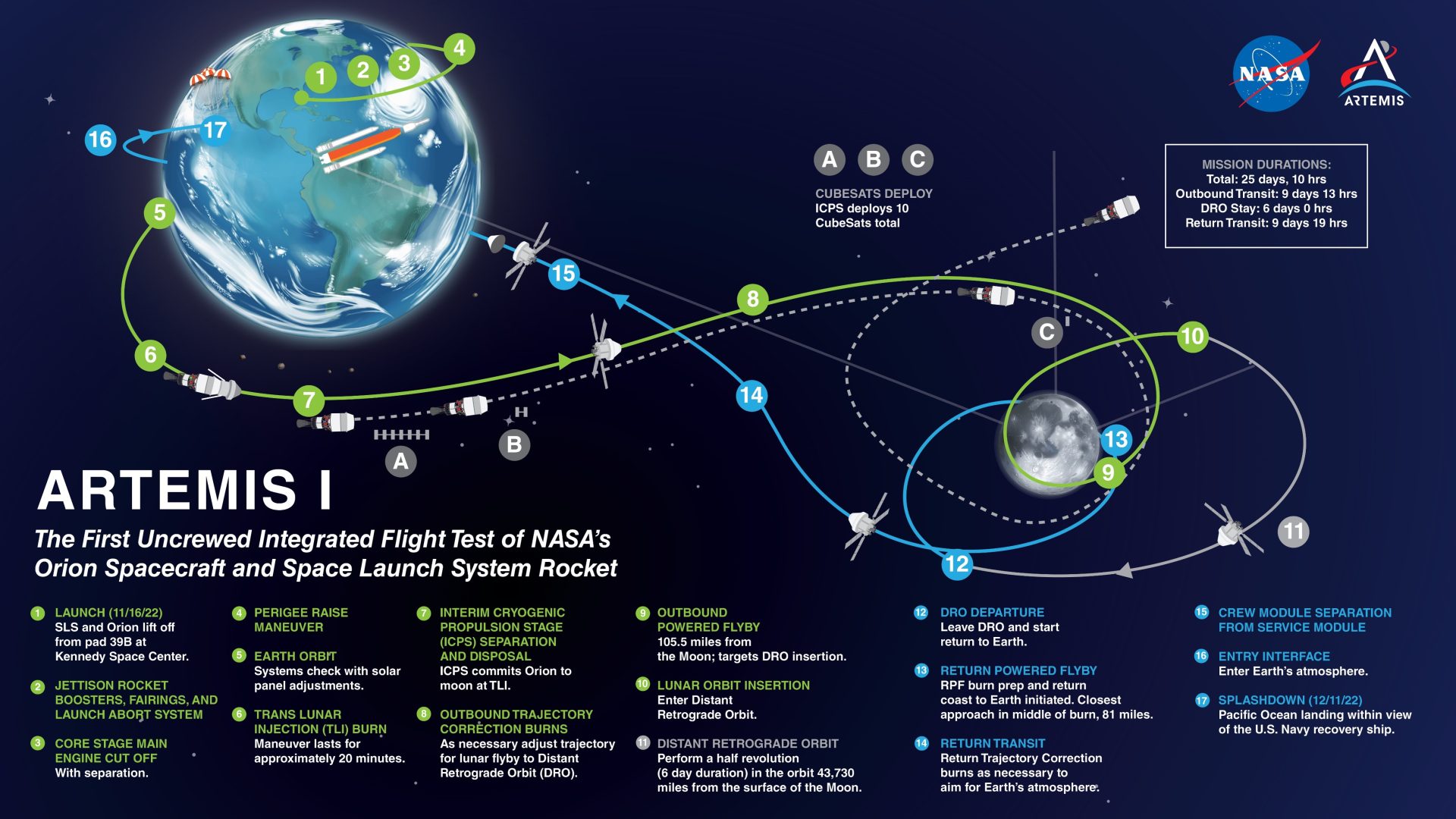
Source: NASA
Artemis 2
The now delayed and scheduled for April 2026 Artemis 2 mission will be the program’s first crewed flight. The overall goal of this mission is to fully test the Orion systems with humans onboard and test the crew interface, guidance, and navigation systems.

Source: NASA
It will carry 4 astronauts, 3 Americans and 1 Canadian, on a 10-day round trip to the Moon orbit and back to Earth. Among them will be Victor Glover who will be the first Black astronaut to fly around the Moon.
The trajectory used will fly 4,600 miles beyond the Moon, as this more complex path will save on fuel, using Earth’s gravity to pull it back.
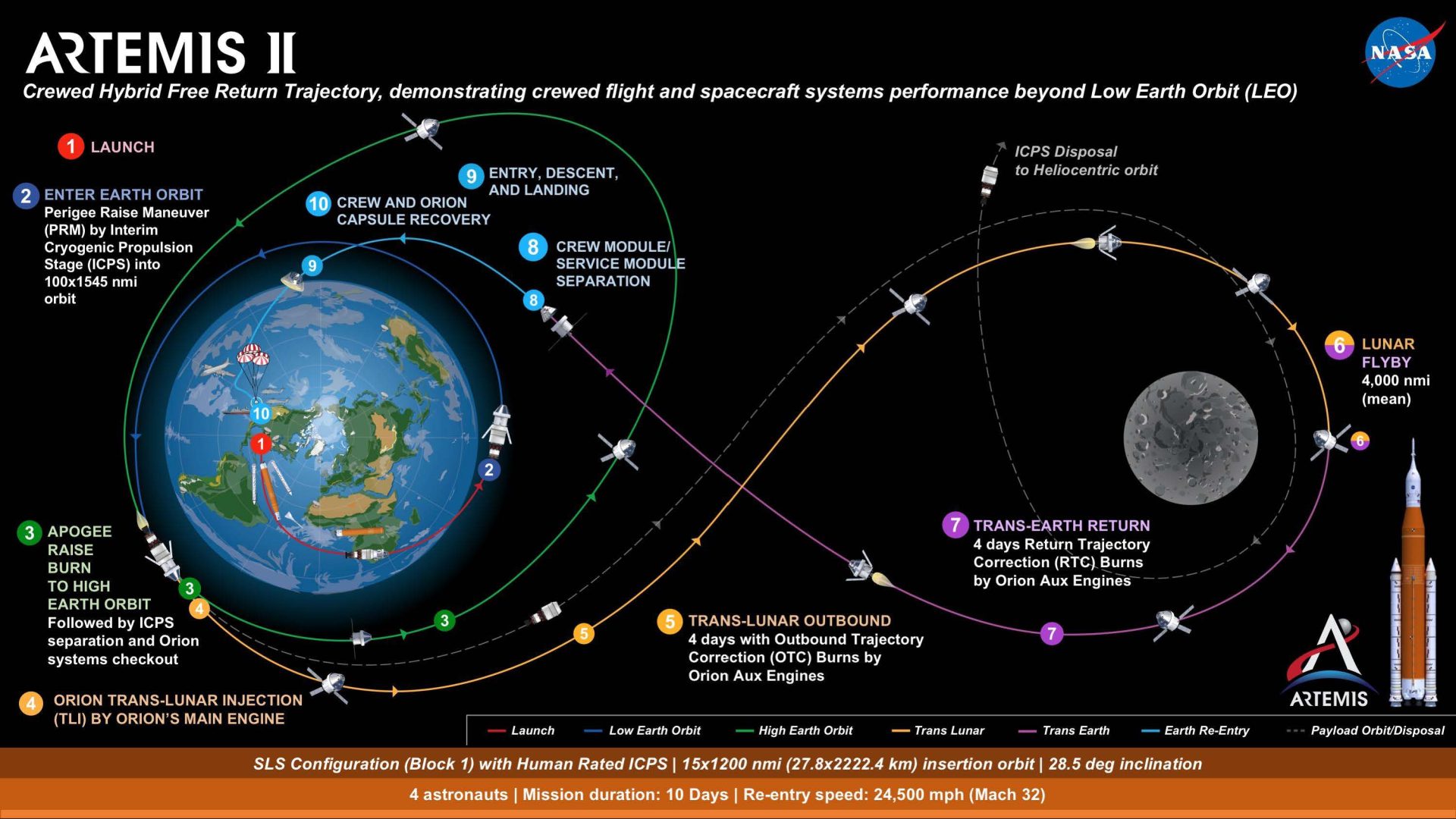
Source: Explore Deep Space
The crew will wear new spacesuits, built to endure the higher radiation level of the cislunar environment.

Source: NASA
Artemis 3
This mission will be the second crewed mission of the program, and the first to land astronauts on the Moon, breaking the 50+ years-long spell since the last Moon landing.
The lift-off will use SLS, the travel to the Moon Orion, and the landing will be done by SpaceX’s Human Landing System (HLS), a Starship rocket variant, before returning to orbit with it.
Before being used by astronauts, the HLS will run a series of tests, followed by SpaceX flying at least one uncrewed demo mission that lands Starship on the lunar surface. The HLS concept will require the refueling of a Starship in Earth’s orbit, to have a full tank when leaving for the Moon.

Source: NASA
The crew will visit the Moon’s south pole to search for water, study its surface, and learn to work on a world outside Earth.
It will also test technologies like spacewalk systems and surface suits which should give much greater mobility than the spacesuit of the Apollo era. The exploration will be done in the Moon’s South Pole.
During the exploration time on the Moon’s surface, Orion will stay in an elongated lunar orbit, keeping on board 2 of the 4 astronauts.
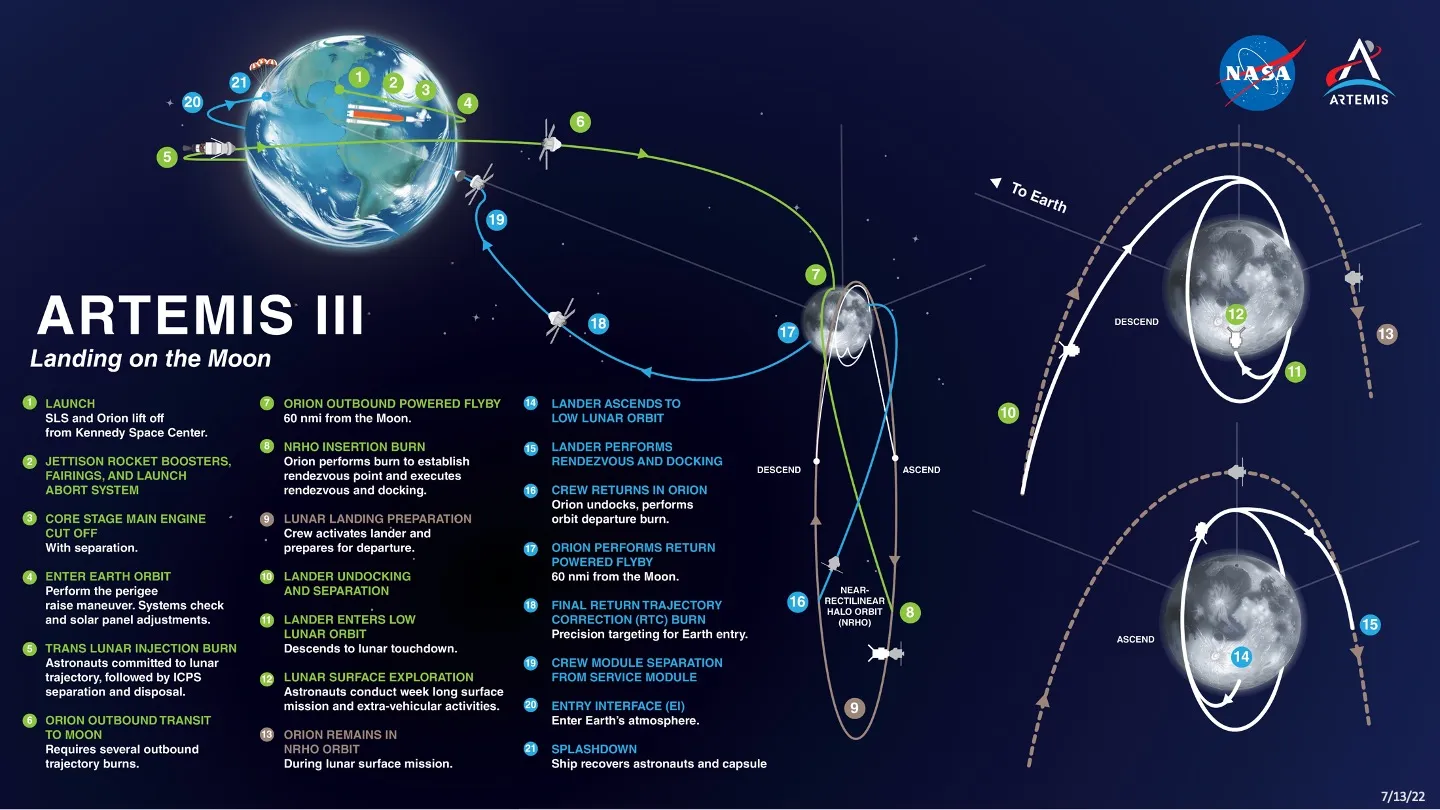
Source: NASA
In the long run, another landing system designed by Jeff Bezos Blue Origins, could sustain missions on the Moon.

Source: NASA
Artemis 4
Artemis 4 is where the goal of permanently settling the Moon starts to take shape. A crucial element will be humanity’s first lunar space station, the Lunar Gateway.
Gateway will be built of 7 main modules, to which the Orion will attach:
- The Crew & Science Airlock, provided by the United Arab Emirates, for performing spacewalks.
- The Lunar-I-Hab, with living quarters and life support, provided by the European Space Agency (ESA) and Japan Aerospace Exploration Agency (JAXA).
- HALO, provided by ESA, a crew living quarter and Lunar Link for high-speed telecommunications with the Moon’s surface.
- Lunar View, also by the ESA, with cargo space and large windows.
- The Power and propulsion systems, including 60kW of electrical power from solar arrays, the most ever produced in a spacecraft.
- The Logistic Module, for cargo delivery and future science experiments, both in and outside the space station, which will be based on SpaceX’s Dragon XL and optimized to carry more than five metric tons of cargo to Gateway in lunar orbit.
- Canada will also provide the robotic arm Canadarm3, which will be able to move to different parts of the station.

Source: NASA
The Power and Propulsion Element (PPE) will be built by Maxar, and the Habitation and Logistics Outpost (HALO) built by Northrop Grumman (NOC -3.39%) and both will first be launched by SpaceX Falcon Heavy rocket.
They will spend about a year traveling to lunar orbit, using high-efficiency solar-electric propulsion and the gravity of the Earth, Moon, and Sun to reach their destination.
Then, Artemis 4 will bring into lunar orbit the crewed Orion spacecraft and Lunar I-Hab Gateway, which will dock with the HALO module.
Gateway’s oval-shaped orbit will provide access to both the North and South Pole areas of the Moon.
Some of Artemis 4’s crew members will land on the moon with HLS, performing field geology, deploying instruments, and collecting samples, and later on, all will return to Earth with Orion.
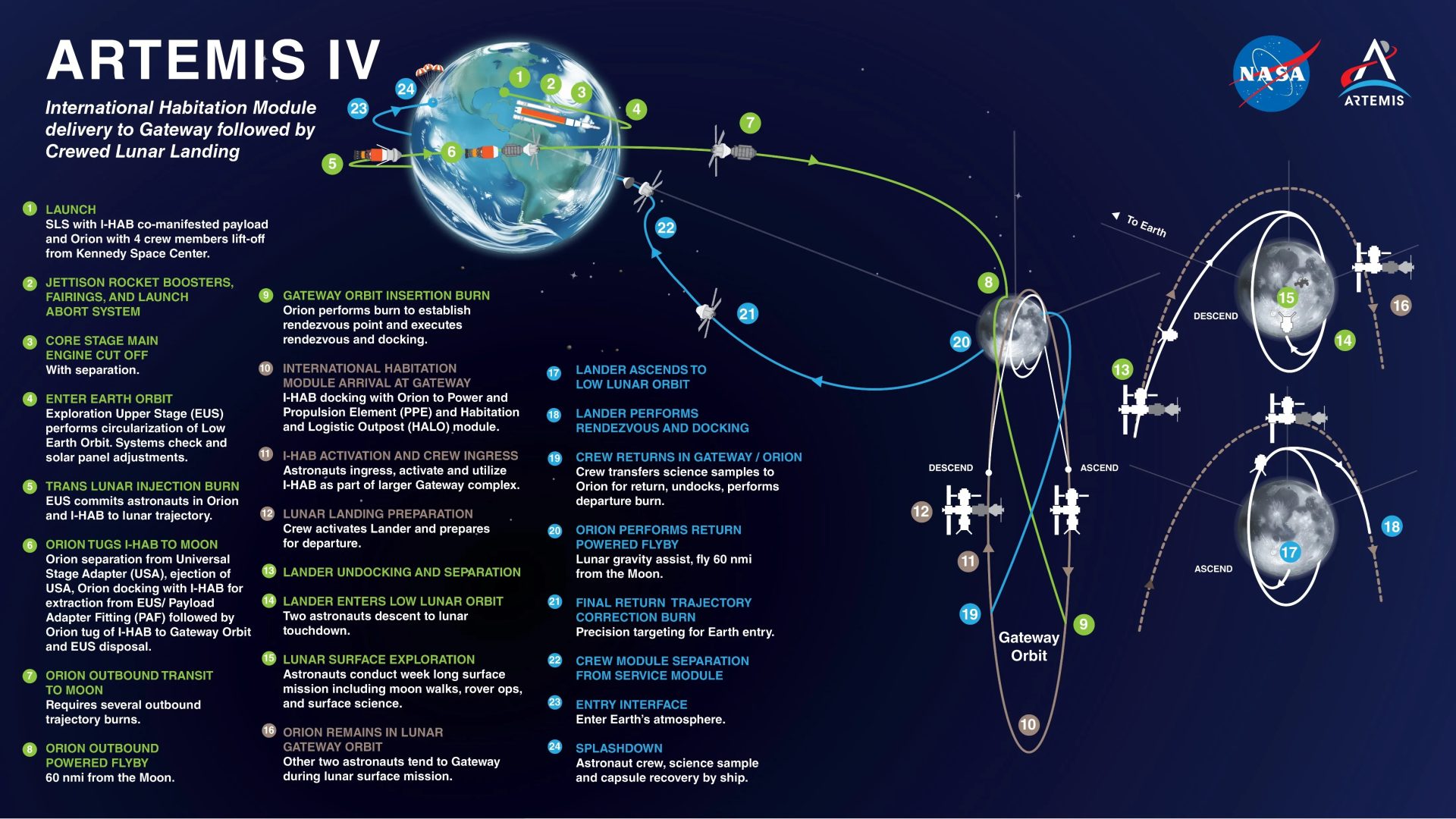
Source: Explore Deep Space
Artemis 4 will not start before 2028, and realistically some time later considering the program’s history of delays and Artemis 3 planned only two years before and the 1-year time required to deliver the first 2 modules to lunar orbit.
Gateway is crucial to the future of manned exploration for a few reasons. The first is its primary goal, as a support, relay, resource deposit, and habitat for lunar exploration. By providing a nearby support structure, it will make the Moon-based activity a lot safer and more efficient. At this stage, 6-day-long missions on the Moon are planned.
The second reason is that the lunar Gateway will also be a gateway to Mars, not just the Moon. This will make it a waypoint where materials can be stockpiled, both from Earth or the Moon, crew gathered, and ships launched.
“We are in a location where we can have a whole crew vehicle come up and be a launch point to Mars from there.
So, the whole point of the Gateway is to have a very robust architecture that can be modified in lots of different ways, used for lots of different things.”
Debra Ludban – Gateway vehicle systems integration manager at NASA
Artemis 5 & Beyond
Artemis 5 is when the other missing modules will be added.
This time when humans go on the Moon, they will also come with an unpressurized rover, radically increasing the capacity of the astronauts to explore and carry materials on the surface.
For now, NASA is considering two types of vehicles on the Moon’s surface: the lunar terrain vehicle (unpressurized ) and the pressurized rover. The pressurized vehicles will work as a mobile base, allowing the astronauts to move from the base camp for much longer periods of time.

Source: Space.com
In the long run, an increasingly permanent Moon base will need its power supply. Even in the polar region, sun power can be a little tricky to deal with on the Moon’s surface, due to a 28-day night and day cycle.
Instead, NASA is looking at nuclear power, with the Fission Surface Power project. NASA is working with the Department of Energy (DOE) and industry to design this fission power system that would provide at least 40 kW of power from four 10 kW units. This could also become the building block of future power supply for Martian bases.

Source: NASA
Artemis Challenges
Is SLS Still Working?
A project like Artemis is bound to suffer from some technical issues and organizational challenges. There are however a few points that are more problematic.
The main issue is the SLS launcher. It was designed as a quasi-replica of the old Saturn 5 in terms of design philosophy and carrying capacity. And it would be considered an impressive rocket if not for the tremendous progress made by SpaceX in the last 10 years.
At the same time, it is clear that for both safety and political reasons, NASA has been very reluctant to depend even more than it already is on SpaceX alone. So SLS is mostly built by legacy space companies like United Launch Alliance, a Boeing (BA -0.58%) & Lockheed Martin Space (LMT -2.07%) joint venture, Aerojet Rocketdyne, and Northrop Grumman (NOC -3.39%).
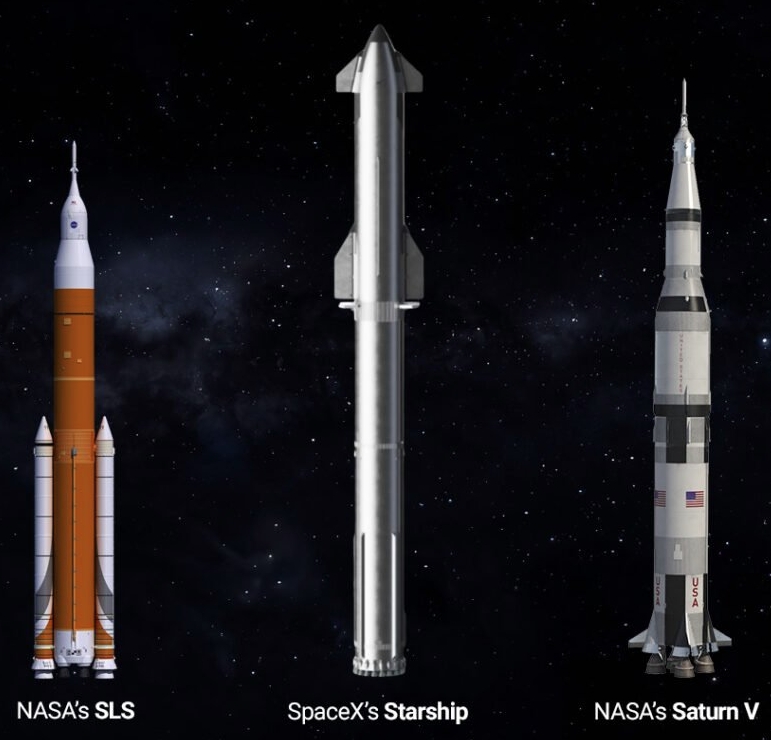
Source: Impulso
However, SLS is expensive, in fact very expensive, with an individual price tag of $2B per launch. At this point, no matter the price tag of SpaceX’s Starship, SLS is grossly more expensive, maybe up to 10-20x more per launch, consuming most of Artemis’ budget, despite an inferior payload.
Of course, when SLS started development in 2011, no one would have bet on SpaceX, but times have changed.
And it seems that Boeing is already preparing for the cancellation of SLS, especially as the US government, under the direction of no one else than Elon Musk, is hunting for inefficient spending. Which would be another failure for Boeing’s space division after the Starliner debacle.
Even with the obvious conflict of interest, it is hard to argue that SLS is a launcher from an older age before reusable rockets have become the norm, and that while SpaceX is leading, companies like Rocket Lab (RKLB -1.7%) or Blue Origin will ultimately bring the needed competition to the reusable rocket sector anyway.
At the same time, SLS is flying reliably, something Starship still cannot say, which is already slowing down Artemis 3.
So the jury is still out if waiting for the lower cost of Starship is worth further delays, or if sticking to SLS for now is the better choice, as NASA is already waiting on Starship anyway…
And the credible promise of a Moon landing by Chinese taikonauts is looming over this debate…
Mission Design
Built around the SLS, the Artemis program has been calculated with massive launch costs, and prepared its Moon exploration accordingly.
If launch costs decrease further, maybe the size of the Moon base as well as of the Lunar Gateway should be reconsidered. Either with larger modules, more of them, or even consider moving to heavy equipment the Moon, like small excavators and machines to turn regolith into bricks.
In that case, the design of nuclear reactors should also be scaled up, up from microreactors to more standard SMRs.
An additional option could be to refurbish the massive volume made of ultra-solid stainless steel fuel tanks of Starship into habitats, especially as the Artemis program already needs Starship-to-Starship in-orbit fuel transfer technology to be mastered.
Overall, despite its initial look as the most ambitious program by NASA since 1972, it is possible that a rethink of Artemis taking into account the capability and price tag of launchers like Starship and New Glenn could make the first version of this plan look tame in comparison.
Artemis Technological Progress
Space Technology
Ignoring the debate about what launcher to use or what the critics say about delays, it is likely that the Artemis program will yield tremendous technological progress, the same way the Apollo program did.
The first part is by providing an incentive and solid market for ultra-heavy launch vehicles. For now, Starship seems to be the most likely to benefit, but other companies will likely be in the competition for the resupply and astronaut transports of the Artemis missions 6 and later, with up to 13 Artemis missions already being considered. And in most cases, reusable rockets are likely the way to go.
Energy production, from solar power satellites to micro nuclear reactors will also progress from the technology being developed to power the lunar Gateway and the Moon base.
Material Sciences & Gadgets
Often invisibly, space programs have created some of the materials now commonplace in the modern world, like for example memory foam (used in pilot seats), smoke detectors, isolating aerogel, foil blankets, fireproof clothing, scratch-resistant glasses, and miniaturized cameras.
It is likely that the effort in making new radiation-proof comfortable spacesuits, space habitats for the Moon, and air filters dealing with the abrasive Moon dust will also produce unexpected payoffs.
3D Printing
This technology is already used to build the engines of both SpaceX’s and Rocket Lab’s rockets. It will likely be massively deployed on the Moon as well, as producing a new part to repair something is a lot simpler than getting it delivered from Earth.
Additive manufacturing is quickly becoming a manufacturing revolution on Earth, and will likely progress greatly by having organizations like NASA paying for the technology to become even more powerful.
For that matter, 3D-printed buildings made from lunar regolith are also a very likely way to build any Moon base for more than 2-4 people. Any technology able to handle the hard vacuum and extremely low and high temperatures of the Moon will likely be easy to adapt to the Earth’s construction sites.
Space Infrastructure
By learning how to live on the Moon and utilize its resources, we are collectively taking the first step toward building the future space infrastructures required for many other projects.
This includes what will be needed to manage asteroid mining or to mass produce solar power satellites. Or maybe even how to mass produce solar panels on the Moon to beam back the power toward Earth.
This will also create the critical mass of demand for advanced space technology allowing to reduce costs. Reducing costs to orbit will create new markets like space tourism, creating further economies of scale.
Conclusion
Artemis has single-handedly restarted a new space race and put back America on the path to land men (and women) on the Moon.
It is aiming way beyond what Apollo has achieved, with much longer visits to the Moon, a permanent presence as a long-term goal, and the active exploration of in-situ resources exploitation. And so it might be remembered as the true first start of mankind as a space-faring civilization, as much if not more than Neil Armstrong’s first steps.
It is however a program that has been decades in the making, and its design illustrates it. Private companies’ innovations in the launch sector and the development of reusable rockets have since demonstrated that more could be done with much less budget.
So in a time of budgetary crisis and government spending overhaul, it is not impossible that Artemis could be delayed by a few years for the sake of efficiency. And lead to even more ambitious goals as a result.
Artemis-Linked Company
Lockheed Martin
Lockheed Martin Corporation (LMT -2.07%)
Lockheed Martin is one of the world’s largest aerospace & defense companies, which we covered in detail in November 2025 in “Lockheed Martin (LMT) Spotlight: A Leader In Defense and Aerospace”.
In short, this is the company behind aircrafts like the Black Hawk helicopters or the F-16, as well as advanced equipment like the F-35, flying radar planes or logistical aircrafts like the C-5 Galaxy & C-130J Super Hercules.

Source: Lockheed Martin
It is also the producer of some of the US military’s most important missile systems like the JAASM, Javelin, ATACMS, and HIMARS, in extremely high demand following the depletion of stockpiles by the conflict in Ukraine.
It is also an important provider of anti-missile defense systems like the naval AEGIS and the THAAD (Terminal High Altitude Area Defense) against ballistic missiles.

Source: Lockheed Martin
Weapons are however not all the company does. Lockheed is the lead contractor for the design, development testing, and production of the Orion spacecraft, maybe the least controversial part of the entire Artemis program. This includes Callisto, a voice-controlled AI assistance system, in partnership with Amazon’s Alexa (AMZN -1.08%), which also incorporates a test for video-chat support from Earth in collaboration with Cisco (CSCO +0.64%).

Source: Lockheed Martin
Would the program be ultimately scaled up thanks to cheaper and more frequent launches using Starship, this could boost the production of Orion as well.
Also related to Artemis, Lockheed has announced it completed critical tests of a lunar solar array prototype that can function in the Moon’s South poles. It however lost to Leidos (LDOS +0.67%) the project for the Artemis rover program.
The company is active in other space programs, like the GOES-R weather satellites, the collection of asteroid samples by OSIRIS-REx, Jupiter probe JUNO, a wearable radiation-shielding vest AstroRad,
Overall, from key military systems to equally important space vehicles and programs, Lockheed Martin is at the forefront of American innovation and seems to have kept its edge a lot sharper than many of its large defense contractor competitors. The company should benefit from later iterations of the Artemis program, as well as many other deep space and Mars-focused missions in the long term.
